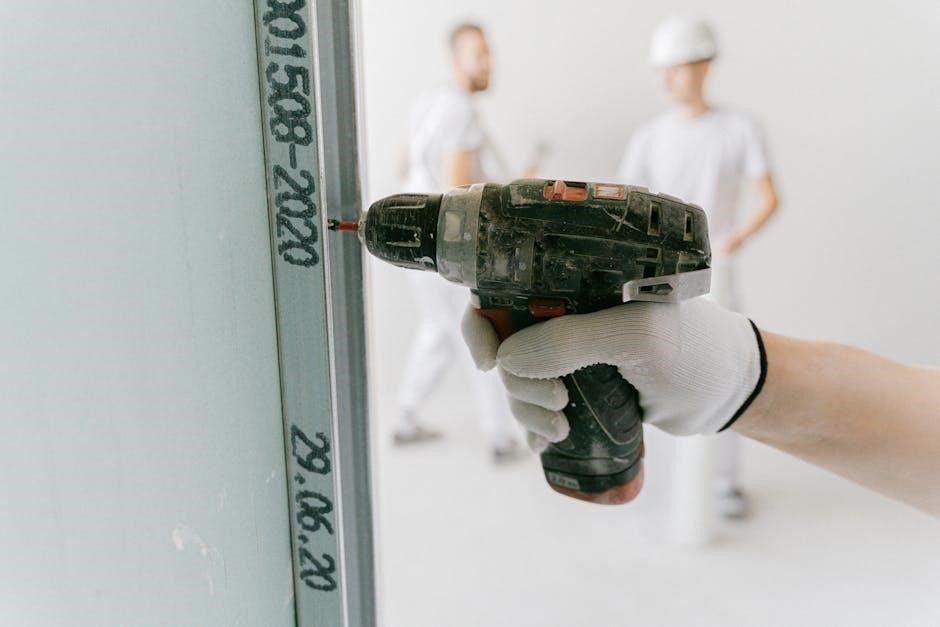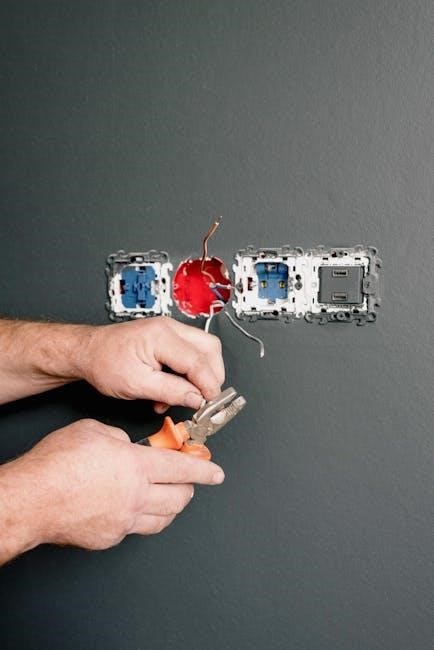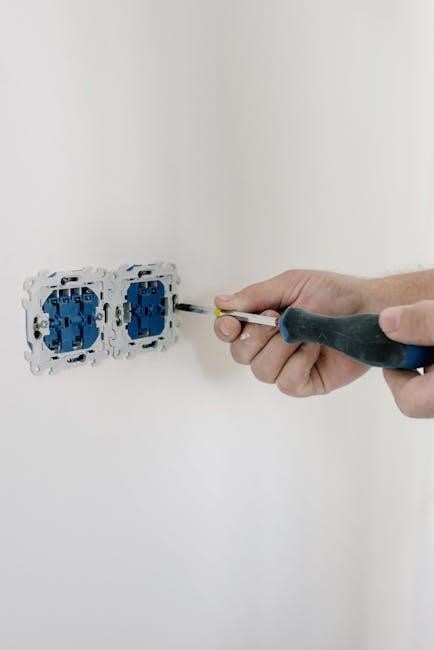Carrier Infinity Thermostat Installation Manual: A Comprehensive Guide
This comprehensive guide serves as your go-to resource for installing your Carrier Infinity thermostat. It offers step-by-step instructions, safety advice, and troubleshooting tips. Refer to the manual for the functions outlined in Version 14, found on MyInfinityTouch.Carrier.com.
Understanding the Carrier Infinity System
The Carrier Infinity system represents a sophisticated approach to home climate control. It goes beyond a simple thermostat, integrating multiple components like furnaces, air conditioners, and air quality systems into a unified, intelligent network. This allows homeowners to precisely manage temperature, humidity, and ventilation throughout their homes, optimizing comfort and energy efficiency.
The Infinity system’s central hub is the Infinity Control, which replaces a conventional thermostat. This control acts as a single interface for all system features, simplifying operation for the user. It communicates with other components through the Infinity Network Interface Module (NIM), enabling seamless coordination and advanced features like zoning and smart home integration.

Understanding the system is paramount to successful installation. The system replaces the conventional thermostat, which provides a single control for all features of the system. The manual reflects software version 1.3 or later. Improper wiring may cause damage to the Infinity system.
Identifying Your Thermostat Model
Before beginning the installation process, accurately identifying your Carrier Infinity thermostat model is crucial. Different models have varying features, wiring configurations, and installation procedures. Referencing the correct manual ensures proper setup and avoids potential damage to the system. The correct manual can be located online.
Locate the model number on the thermostat itself. It’s typically found on a label affixed to the back or side of the unit. Look for a series of characters, such as “SYSTXCCITC01-B” or “SYSTXCCWIC01-B”. This number is your key to finding the correct installation manual and any model-specific instructions.
Once you have the model number, visit the Carrier website (HVACPartner.com) or MyInfinityTouch.Carrier.com. You will find a comprehensive database of manuals and resources. Ensure that the features and functions that you outline match the software version that is on your thermostat. Using an incorrect manual can lead to install issues.
Safety Precautions Before Installation
Prioritizing safety before commencing any electrical work is paramount. Installing a Carrier Infinity thermostat involves working with low-voltage wiring, but precautions are still necessary to prevent electrical shock or damage to the equipment. Always disconnect power to the HVAC system at the circuit breaker before beginning the installation. This eliminates the risk of electrical shock during the wiring process.
Never work on the system while it is powered on. Double-check that the circuit breaker is in the “off” position before proceeding. Use a non-contact voltage tester to verify that power is indeed disconnected from the thermostat wiring.
Handle the thermostat and wiring with care. Avoid touching any exposed wires or terminals while the power is on. If you are unfamiliar with electrical wiring, consult a qualified HVAC technician or electrician to perform the installation. Incorrect wiring can damage the thermostat or the HVAC system, so do not attempt the installation if you are not confident in your abilities. Follow all safety guidelines.
Tools and Materials Required

Successful installation of your Carrier Infinity thermostat hinges on gathering the correct tools and materials. A Phillips head screwdriver is essential for removing the old thermostat and securing the new one. Small, flat-head screwdrivers are needed for wiring connections. A wire stripper/cutter is used to prepare the thermostat wires, ensuring clean and secure connections. A level ensures the thermostat is mounted straight on the wall.
You’ll require the new Carrier Infinity thermostat itself, along with its mounting hardware. Thermostat wire (usually 18-gauge) might be needed if extending or replacing existing wiring. Wire connectors or wire nuts are crucial for safe and secure connections. A non-contact voltage tester verifies power is off during the installation. Drill with appropriate drill bits might be required for new mounting holes.
Safety glasses protect your eyes from debris. A flashlight or work light provides adequate illumination; Finally, the Carrier Infinity thermostat installation manual will provide specific guidance. Having these tools and materials readily available ensures a smooth installation process.
Step-by-Step Installation Process
The Carrier Infinity thermostat installation involves several key steps. First, turn off power to the HVAC system at the breaker to ensure safety. Remove the old thermostat from the wall, carefully noting the wire connections. Label each wire with tape and a marker to match the corresponding terminal on the old thermostat. Disconnect the wires and remove the old mounting plate.
Mount the new Carrier Infinity thermostat mounting plate to the wall, using a level to ensure it is straight. Connect the wires to the corresponding terminals on the new thermostat, referring to your labeled wires and the installation manual. Secure the thermostat to the mounting plate. Turn the power back on at the breaker.
Follow the on-screen prompts to configure the thermostat settings, including date, time, and system preferences. Test the heating and cooling functions to ensure proper operation. If the system doesn’t respond, double-check the wiring connections. Consult the troubleshooting section of the manual if issues persist. This step-by-step approach ensures a successful installation.
Wiring Connections for Infinity Thermostats
Proper wiring is critical for the Carrier Infinity thermostat to function correctly. Infinity systems typically use a four-wire ABCD connection. Ensure the A, B, C, and D wires are connected to the corresponding terminals on both the thermostat and the HVAC system’s control board. Incorrect wiring can damage the Infinity system.
Before connecting any wires, always turn off the power to the HVAC system. Refer to the wiring diagram in the installation manual for your specific model. If you are replacing an older thermostat, carefully label each wire before disconnecting it to avoid confusion. If your system includes an Infinity Network Interface Module (NIM), ensure it is properly connected to the thermostat.
For systems with additional features like humidifiers or ventilation, there may be additional wiring requirements. Consult the manual for specific instructions. If you are unsure about any wiring connections, it is best to consult with a qualified HVAC technician to prevent damage to the system. Always double-check your connections before restoring power.
Connecting to the Infinity Network Interface Module (NIM)
The Infinity Network Interface Module (NIM) facilitates the integration of Carrier HRV or ERV systems with your Infinity control, eliminating the need for a separate wall control. This module connects to the Infinity control, providing a unified interface for managing all aspects of your HVAC system, including ventilation.
To connect the NIM, first ensure that the power to the HVAC system is turned off. Locate the NIM and the Infinity control. Use the appropriate wiring, typically a four-wire connection, to link the NIM to the Infinity control. Refer to the installation manual for the specific wiring diagram for your NIM model. Ensure that all connections are secure and properly insulated.
Once the physical connections are made, you may need to configure the Infinity control to recognize and communicate with the NIM. Access the settings menu on the Infinity control and follow the prompts to add or configure the NIM. This process may involve selecting the type of HRV or ERV system connected. After configuration, test the system to ensure that the ventilation features are functioning correctly through the Infinity control.
Initial Setup and Configuration
After the physical installation and wiring are complete, the initial setup and configuration of your Carrier Infinity thermostat are crucial for optimal performance. Begin by powering on the HVAC system. The thermostat should display a startup screen, prompting you to begin the configuration process. Follow the on-screen instructions to set the date, time, and your location. This information is essential for accurate scheduling and weather updates.
Next, configure the system settings according to your specific HVAC setup. This includes specifying the type of heating and cooling system you have (e.g., heat pump, furnace, air conditioner), as well as any additional components like a humidifier or ventilator. The thermostat will guide you through these settings, asking for details about your equipment.
Calibrate the thermostat by conducting a test run of both the heating and cooling systems. Monitor the temperature readings and adjust as needed to ensure accurate temperature control. You can also customize settings such as fan speed, temperature preferences, and scheduling options to match your comfort needs and energy-saving goals. Consult the owner’s manual for detailed guidance on these advanced settings.
Wi-Fi Connectivity and App Setup
Connecting your Carrier Infinity thermostat to your home’s Wi-Fi network unlocks remote control and advanced features through the Carrier app. To begin, ensure your thermostat is powered on and in setup mode. Navigate to the Wi-Fi settings on the thermostat’s screen and select your home network from the list of available networks.
Enter your Wi-Fi password when prompted. Once connected, download the Carrier Infinity app from your mobile device’s app store. Create an account or log in if you already have one. Follow the app’s instructions to add your thermostat to your account. This process typically involves scanning a QR code on the thermostat or entering the device’s serial number.
After successful registration, you can control your thermostat remotely through the app. Adjust temperature settings, create schedules, view energy usage reports, and receive alerts. Ensure your mobile device has a stable internet connection for seamless control. Regularly update the app and thermostat firmware to access the latest features and security enhancements. Refer to the app’s help section or Carrier’s support website for troubleshooting tips.
Troubleshooting Common Installation Issues
Encountering issues during your Carrier Infinity thermostat installation is not uncommon. One frequent problem involves incorrect wiring, which can damage the system. Always double-check the wiring against the manual’s diagrams, ensuring each wire is connected to the correct terminal. If the thermostat doesn’t power on, verify the power supply and check for any tripped breakers.
Wi-Fi connectivity problems are also common. Make sure your thermostat is within range of your router and that your Wi-Fi password is correct. Restarting both the thermostat and the router can often resolve connection issues. If the thermostat displays error codes, consult the manual for explanations and troubleshooting steps. Sometimes, a software update is required to fix compatibility issues or bugs.

For systems not responding to thermostat commands, check the Infinity Network Interface Module (NIM) connection. Ensure it’s properly connected and functioning. If problems persist, contacting a qualified HVAC technician is advisable to avoid further damage to the system. Always prioritize safety and consult professional help when needed.
Accessing and Utilizing the Online Manuals and Resources
To fully leverage your Carrier Infinity thermostat, accessing and utilizing the online manuals and resources is essential. Begin by visiting the official Carrier website, specifically the HVACPartner.com site or the MyInfinityTouch.Carrier.com portal. Here, you’ll find a wealth of information, including the latest software releases, product literature, and detailed installation manuals.

The online resources often include troubleshooting guides, wiring diagrams, and FAQs to assist with installation and operation. Look for the downloads section to access PDF versions of the manuals, allowing you to view them on various devices. Many resources offer video tutorials demonstrating specific procedures, such as initial setup, Wi-Fi connectivity, and advanced configuration;
Furthermore, explore online forums and communities where users share their experiences and solutions to common issues. Carrier also provides technical training and support materials for contractors, which can be helpful for understanding complex aspects of the system. Remember to check for updates regularly, as software and documentation are frequently revised to improve functionality and address user feedback.
